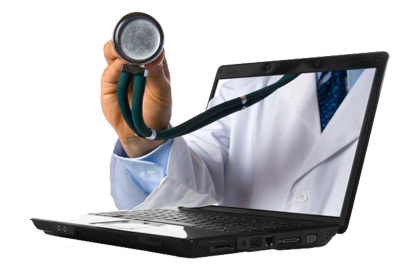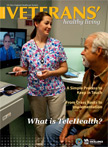Veterans' Healthy Living, Summer 2013
What is Telehealth?
VHA Telehealth Service uses health informatics, disease management, and telehealth technologies to target care and case management to improve access to care, improving the health of veterans. Telehealth changes the location where health care services are routinely provided.
The value VA derives from telehealth is not in implementing telehealth technologies alone, but how VA uses health informatics, disease management and telehealth technologies to target care/ case management thereby facilitating access to care and improving the health of veterans.
Information courtesy of http://www.telehealth.va.gov/
 Telehealth Across VISN 1
Telehealth Across VISN 1
It is estimated that roughly 830,000 Veterans across the country will receive the benefits of telehealth during fiscal year 2013. Kathleen Crowley, MSN, RN, VISN 1 Telehealth Director, says Veterans use telehealth because it can decrease their travel and increase their access to healthcare. "It doesn't mean that care can be provided 100 percent by telehealth, but it's incorporated into the treatment plan for the patient."
In VISN 1, there are three unique types of telehealth: Clinical Video Telehealth, Store-and-Forward Telehealth, and Home Telehealth.
Clinical Video Telehealth
Veterans participating in Clinical Video Telehealth travel to the closest clinic with the technology and interact with a provider who was at the medical center. Now, IP Video into the Home is an additional pathway whereby the provider is still stationed at a medical facility, but Veterans in their own homes on their own computers can have practically the same encounter as being at the
medical facility.
"Sometimes it is an enormous amount of work for caregivers to get chronically ill patients into a car or an ambulance and get them to a CBOC," said Crowley. "Now, depending on the necessity of the visit, Veterans have an option to stay in their own homes."
Store-and-Forward Telehealth
Store-and-forward telehealth consists of collecting information, such as data, sound, or images, and then forwarding the information to a specialist at another site, where it is retrieved and evaluated. Available programs in VISN 1 include TeleRetinal Imaging, TeleDermatology, TeleEKG, TelePFT, and TeleVascular.
Home Telehealth
Home Telehealth Case Management, the longest running telehealth program in VISN 1, involves equipping Veterans with monitors. "This enables the Veteran to answer health related questions, such as about weight or blood pressure, on a daily basis. The answers are transmitted to the RNCare Coordinator at the medical center via webpage, which helps the Care Coordiantor decide whether
a patient should remain at home or go to a medical facility," Crowley explains.
For more information on telehealth services, visit http://www.telehealth.va.gov.

















